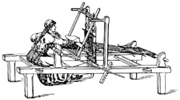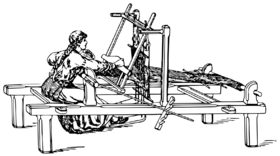Ateneus de Fabricació 2018/11/15
De teixidora
Quan: des de 15-novembre-2018 fins a 15-novembre-2018 · Hora: 16:30 - 17:30· On: Gran Via Venue, HALL 1 and 2, Fira Barcelona. Av. Joan Carles I, 64 08908 L’Hospitalet de Llobregat · (mapa) · Llengua: es-castellà Organitza: Ajuntament de Barcelona, Dimmons UOC
Hashtag:#ShareBcn2018_Xarxes socials:
The third edition of the Sharing Cities Summit will take place in Barcelona 12-15 of November 2018. It follows the previous edition of the Sharing City Summit held in 2017 in NYC, and in 2016 in Amsterdam. The event will gather Mayors and Deputy Mayors from leading cities from around the world, and actors of the sharing ecosystem, to discuss how the continuous growth of sharing economies impacts the life and economic development of the cities. The participants will consider what innovative measures can be taken to meet the challenges and opportunities we face, such as how to differentiate between digital platforms, based on the model of collaboration of its users that is applied. This year’s Summit will focus on defining a “Declaration of principles and commitments for a Sharing City”, and will stimulate concrete collaboration between cities.
After the Mayors encounter, on 12 November there will be a public event in the evening. On 13, 14 and 15 November, a part of this year’s Smart City Expo World Congress (SCEWC18), there will be topic at the congress dedicated to “Inclusive and Shared Cities“
The talks and debates of the summit are documented through collaborative reporting to Teixidora.
“… Speakers: David Mesa (Cárceles de invención: hacia una arquitectura), Beatriz Guedán (Arquitectura tèxtil)
Documentació d'aquesta sessió
· ![]() apunts ·
apunts ·
 Apunts i cròniques
Apunts i cròniques
Apunts presos a l'esdeveniment, cròniques, ressenyes i documents de conclusions.
Apunts
Apunts copiats al wiki:
https://pad.femprocomuns.cat/p/sharebcn2018ateneusfab
En Mauricio Córdova ha fet un filtre d'aigua que permet veure aigua contaminada d'un bassal, la desembocadura del riu més contaminat del planeta... i ha aconseguit fer-ho amb un preu de venda al públic molt i molt més barat del preu de mercat i un aparell molt portable, còmode... www.faircap.org
La Lonne Van der Sterren és una estudiant holandesa d'antropologia i ha fet una estada a Barcelona d'uns mesos per tal d'estudiar l'ecosistema maker de la ciutat, (ha estat caminant per molts espais makers de la ciutat darrerament) i he pensat que ella pot donar un anàlisi molt acurat i actual de com està la ciutat en aquest sentit i quin espai ocupen els ateneus de fabricació.
Beatriz Guedán
My thesis at Elisava. about the makers movement, with a clear interest in textiles and architectural systems and plastics, specifically bubble wrap.
At Ateneu de Fabricació de les Corts, they taught me about the technology.
I could go there whenever I could and develop my project so it was the perfect opportunity to develop this project.
As I learned how the machine worked I discovered I could not simply print this.
I started experimenting with machines in order to discover what is best the way.
Finally, I design my bag, which is open (anyone can download).
I decided to include different handles and these can be changed.
All the components have the same structure, but their role depends on their function and where they are found in the bag.
The thickness in the centre of the body of the bag and at the bottom is thicker because it needs to give more support. At first glance it seems like one piece but there are many parts. By showing you this process I am showing you alternatives to the linear economies. So in this example we are proloning the life of the plastic by reusing it. The project is defined by 11 principles of the maker movements and circular economies.
David Mesa
When I was a kid I was inspired by computer games. The connection between the body and the immersive experience. How can fictional characters have an emotional resonance. The opportunity to explore a fictional reality made you feel a part of it. Some years later appeared the sims. There was the possibility of creating your own characters. These days there is Minecraft. Some years later I studied architecture. You can recreate 3 dimensional space through rendering. When I arrived to my final year in architecture I decided to use virtual reality. I used Unreal Engine which is used for making video games. I had the opportunity to collaborate as part of a research group. We asked 'What is Architecture?'. I started with a hypercude. The project was based on developing 8 spaces in these abstract cubes. I gave a differenct character to each cube. The distinction between floor, walls, ceiling is not relevant in 4 dimesional space. Why was virtual reality important? The only way to experience a 4 dimensional world is in VR. We worked with mobile VR with students. To sum up. When I was 5 we had one relationship with a screen and today kids have mobile VR and so one can imagine what we could see in the future.
Lonne Van der Sterren
I'm an anthropolgist. I came to Barcelona in February this year 2018. I wanted to work with the 3D printer. We wanted something for our home. The next day it was printed. Instead of paying you exchange a service so for example some skills. We have the signs in the building and they are not so nice. If you like we can show you how to use the laser printer and you can print some new ones out. So I learned to use the laser cutter next week. What I really like about the Ateneus is that you can just walk in and start talking to people, it was very interesting and even though I never thought as an anthropologist I could learn these things I did learn how to use a 3d printer and a laser cutter. It was really cool.
Mauricio Córdova
From Peru. In the 90's we had a Cholera outbreak and people died from contaminated food. After my studies I returned and I was walking with a friend in the rainforest and I realised that even in the most pristine places in the world you cannot drink the water because it is contaminated. I am an economist and not an engineer but I had heard of the maker movement and I was interested to see if I could make a water filter at home. I came to Barcelona 3 years ago and at Fabrica de Sol we made some prototypes. In the end we came up with a final product with support from a foundation in the UK. We designed a small low cost filter that you do not use any chemicals. We did the testing collaboratively with the University of Barcelona and in Switzerland. In Peru there were 10 million bacteria per 100 ml and it filters all of them. Now we want to work with NGOs.
German Delórme
Prototype of a lamp based on arduino. In lighting nowadays you need a control system so save energy and make it interactive. I am working on this project at the Ateneu. Arduino devices allow you to connect this with digital systems.
el taller ![]()
Col·labora completant o afegint la documentació que falta.
Hi ha: > ![]() apunts o cròniques
apunts o cròniques
No s'ha incorporat documentació de:
-
 Presentacions o material projectat
Presentacions o material projectat -

 Imatges
Imatges -
 Vídeo
Vídeo -
 Àudio
Àudio
Teixim connexions
Teixim una xarxa de connexions partint d'aquest esdeveniment'. Extraiem i etiquetem continguts de la documentació generada per explorar relacions amb altres esdeveniments, identificar narratives, elements pel debat i generar cartografia dels actors implicats.
 Metadades
Metadades
Informació estructurada de l'esdeveniment que permet connectar-lo amb altres continguts a Teixidora.
Paraules clau: economia col·laborativa, innovació social, innovació digitaljocs, arquitectura, fabricació, impressió 3D, makers, economies lineals, economia circular, moviment maker, reutilitzar, Realitat Virtual, Realitat Augmentada, còlera
Mostra paraules clau en altres llengües · anglès ·
Paraules clau en anglès: social innovation, digital innovationmaker, games, architecture, 3D printing, linear economies, circular economy, maker movement, reuse, Virtual Reality, Augmented Reality, cholera
Mostra paraules més freqüents al text
Intervinents: David Mesa, Beatriz Guedán, Mauricio Córdova, Lonne Van der Sterren, German Delórne
Persones mencionades:
Projectes mencionats: Faircap, Ateneus de Fabricació, Ateneu de Fabricació de Les Corts, Fàbrica del Sol, Arduino
Organitzacions mencionades: Elisava, Ateneu de Fabricació de les Corts
Llibres i publicacions citades:
 Diagnòstic
Diagnòstic
Diagnòstic i/o avaluació que s'ha fet a l'esdeveniment.
Riscos / debilitats / mancances
Oportunitats / fortaleses
Propostes
el taller ![]()
Col·labora estructurant els resultats a partir de la documentació existent
A més dels resultats mostrats en aquesta pàgina, Teixidora permet mostrar de forma estructurada els següents resultats:
- Cites (què s'ha dit)
- Alternatives
Si creus que d'aquesta sessió se'n poden extreure alguns d'aquests resultats edita la pàgina i posa-ho a les caselles previstes a la secció "resultats".
Lloc
Mapa d'ubicació
Localització: Gran Via Venue, HALL 1 and 2, Fira Barcelona. Av. Joan Carles I, 64 08908 L’Hospitalet de Llobregat ·
el taller 
![]() Afegir a teixidora esdeveniments similars a aquest
Afegir a teixidora esdeveniments similars a aquest
(es copiaran els continguts principals però no el títol ni el buidat)
Afegir esdeveniment que sigui...
![]() amb mateixos organitzadors i lloc
amb mateixos organitzadors i lloc ![]() al mateix lloc
al mateix lloc
![]() Reutilizació de continguts : els continguts de teixidora es poden re-publicar en viu a altres webs.
Reutilizació de continguts : els continguts de teixidora es poden re-publicar en viu a altres webs.
![]() sindicació Atom d'aquesta pàgina
sindicació Atom d'aquesta pàgina
![]() sindicació RSS d'aquesta pàgina
sindicació RSS d'aquesta pàgina
![]() Afegir a un calendari amb iCal
Afegir a un calendari amb iCal




